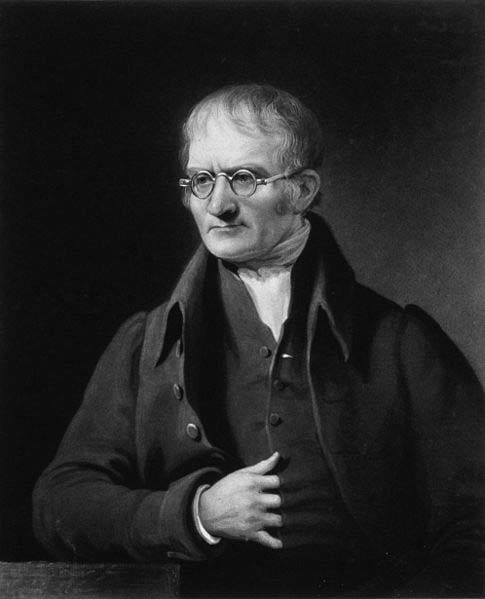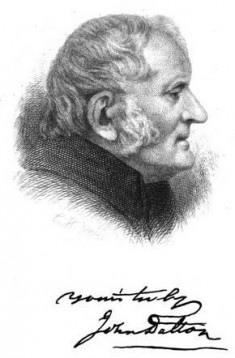| John Dalton | |
|---|---|
 |
|
| Chemist | |
| Specialty | Chemistry, Physics, Meteorology |
| Born | Sep. 6, 1766 Eaglesfield, Cumberland, England |
| Died | July 27, 1844 (at age 77) Manchester, England |
| Nationality | English |
John Dalton was an English scientist who was born in Eaglesfield, near Cockermouth, in the northwest region of England in 1766. Despite the fact that he was born into a poor family of weavers, Dalton embraced education and proved to be a very precocious child.
Dalton’s Early Years
Dalton distinguished himself academically at a very early age by achieving the remarkable accomplishment of being appointed a teacher in the local school when he was only 12 years old. He moved to nearby Kendal when he was 15, taking a post as principal of the Quaker school in that town.
Even at such a young age, Dalton was very diligent in keeping diaries. From these diaries, we know that he had developed an interest in scientific and mathematical subjects. In fact, he had already begun to study Isaac Newton’s great work, Principia. Even more remarkable, he was studying it in Latin, the language in which it had been written.
Life in Manchester
When Dalton was 27, he moved to the city of Manchester, where he continued working as a teacher at New College. He became a prolific writer on a wide range of topics ranging from medical issues to grammar to meteorology. Dalton was color blind, and this led him to devote much valuable research into understanding the condition. This work was so influential that the condition became known as Daltonism. He correctly surmised that the condition must be hereditary.
Manchester Literary and Philosophical Society
John Dalton became a member of the Manchester Literary and Philosophical Society, and his membership gave him permission to use the laboratories to conduct experiments. It was during this period that he formulated what became known as Dalton’s Law, which states that the total pressure exerted by a mixture of gases is equal to the sum of the pressure exerted by each gas in the mixture.
In 1808, Dalton published a tome of more than 900 pages, which he entitled A New System of Chemical Philosophy. In a short section of this book, he became the first scientist to identify the true nature of atoms, and his conclusions were pretty much the same as how we understand atoms today.
Working with Atoms

He proposed that all matter is made up of tiny particles. His views were so radical that many eminent scientists dismissed them. He was the first scientist to attribute an atomic weight to elements. While his efforts were not entirely accurate, his principles were sound. He also came to the conclusion that atoms were indestructible, and that they could not be created.
Two years later, Dalton published an appendix to the book, where he explained further how the atoms that made up any particular element all had the same weight and size. The weight and size of the atoms of different elements are different from each other. Dalton’s work can accurately be described as the foundation of modern chemistry.
Honors and Legacy
John Dalton was a retiring individual who was offered many prestigious awards, most of which he declined. However, in 1817, he accepted the position of president of the Manchester Literary and Philosophical Society, and he remained in that post until his death. He declined an offer from the Royal Society to become a member. When Oxford University wanted to offer him an honorary Doctorate of Science in 1832, he reluctantly accepted it.
His contribution to science and education was widely recognized during his lifetime, something that eluded many other scientists. He was granted a pension by the government of the day in 1833. Three years later, the government doubled the value of his pension. A statue of Dalton was erected in London in 1834, which was an impressive tribute to a man who was still alive.
Dalton died at his Manchester home in 1844, and the city granted him a full civic funeral. In a significant testament to his fame and the prestige he had established, the attendance at his funeral was estimated at an extraordinary 40,000 people.